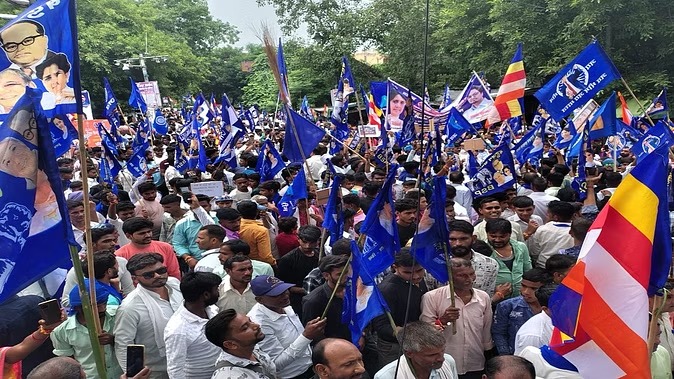India Tomorrow
NEW DELHI: While the nationwide Bharat Bandh call given by Dalit groups against “quota within the quota” for dalits” was quite successful on August 21, the mainstream media completely ignored it. There was not much reporting about it in national media in Delhi though some regional papers published from state capitals, particularly Hindi-speaking areas, gave coverage.
The “quota within quota” was given by the Supreme Court on a petition that demanded a separate quota for the lowest in the social and economic ladder in the Dalit community. The petitioner had stated that the Dalit community is not homogenous and hence, a separate quota be given to those at the bottom of the Dalit ladder to uplift the poorest of Dalits.
But this quota verdict by the Supreme Court is being interpreted by Dalit groups as a bid to divide the Dalit community politically. They are now demanding that the Centre bring an ordinance to neutralize the Supreme Court verdict.
It was in this context the Dalit groups organised a Bharat Bandh to bring pressure on the government and political parties to ensure that the verdict was not implemented and an ordinance is issued to make the verdict ineffective.
Seven states viz Bihar, Uttar Pradesh, Madhya Pradesh, Jharkhand, Rajasthan, Uttarakhand and Odisha witnessed mixed responses to the Bandh call given by different organizations of the Dalit communities including the Bahujan Samaj Party, Dalit Sena, and the Bhim Army. In Bihar, the Bandh was supported by RJD, CPI-ML, and NDA ally Chirag Paswan’s Lok Janshakti Party (Ramvilas).
The bandh was most successful in Bihar. Police resorted to police lathi-charge and the use of water cannons at Patna as the protesters tried to break the barricade to hand over their memorandum to the governor. At many places, the protesters sat on railway tracks to block the movement of the trains. National Highways at several places were also blocked. However, trains were allowed to move after some time.

Dalit protesters at Arrah in Bihar
In Uttar Pradesh, leaders belonging to BSP, Bhim Army, Samajwadi Party and Congress staged a sit-in at Ambedkar’s statue in Lucknow’s Hazratganj. The protesters demanded the government pass a law against the SC’s verdict in Parliament. They chanted slogans like ‘Stop dividing the SC and ST.’ The protesters blocked the road in Ambedkar Nagar in East UP.
In Rajasthan, the Bandh evoked a good response. In cities like Jaipur, Barmer, Jalaur and Jodhpur SC-ST organisations took rallies to protest the sub-classification in the reservation. They also chanted slogans demanding the cancellation of the SC verdict in this regard. Educational institutions were closed in many districts and the internet was also shut in a few districts.

Dalit protesters in Patna, Bihar.
In Madhya Pradesh, there was a mixed response to the Bandh call but it was effective in the Gwalior-Chambal area. In the capital Bhopal, the Bandh did not witness any significant response.
The response to the Bandh call has put the Bharatiya Janata Party and Prime Minister Narendra Modi in a tight spot. The Dalit organisations accused the government led by Mr. Modi of dividing the Scheduled Castes through the apex court’s verdict. Seemingly the BJP is in support of the SC’s verdict but their leaders are not openly coming in favour of it.
The allies of the BJP-led NDA (National Democratic Alliance) are at loggerheads over the SC’s verdict. While Dalit leader Chirag Paswan clearly demands the revision of the order of the Supreme Court, another Dalit leader Jitan Ram Manjhi openly supports the court order. Chirag sees the verdict as divisionary but Jitan Manjhi says that the rich Dalits get the maximum benefit of the reservation meant for Scheduled Castes.

Jitan Manjhi demands that there should be a quota within quota for the underprivileged castes of the SC. Jitan Manjhi had opposed the Bandh call saying that those who oppose the ‘Quota within Quota’ are selfish. He alleged that ninety percent of benefits are availed by a couple of influential Dalit communities and the rest are still deprived.
Even Nitish Kumar’s JD(U) is in favour of the sub-categorisation of SCs. It was Nitish who divided the SC into Dalit and Mahadalit in 2007 and the Mahadalits enjoy some extra benefits of the government schemes under this sub-classification. Though there is no benefit in the reservation of jobs of this sub-classification, the new court verdict allows the government to fix a special quota within the quota.

Bharat bandh impact in Chhattisgarh
It will be interesting to keep an eye on what strategy the BJP adopts to tackle this challenge from the Dalit communities. It will be pertinent to see if the government goes for an ordinance to overturn the order of the Supreme Court.

Bharat bandh impact in Bareilly, Uttar Pradesh
It may be recalled that on August 1, 2024, a seven-judge bench of the Supreme Court led by Chief Justice DY Chandrachud stated that states, that are empowered to make sub-classifications within SCs and STs, to grant smaller quotas within the larger reservation for reserved categories to uplift the most underprivileged sections. Chief Justice Chandrachud said, “Historical and empirical evidence demonstrates SCs are a socially heterogenous class.” There was also a remark regarding the possible creamy layer in SCs and STs.





